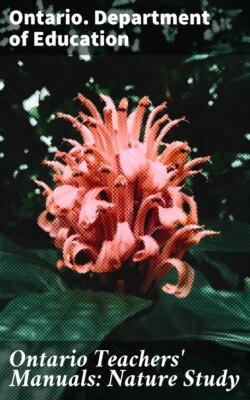Читать книгу Ontario Teachers' Manuals: Nature Study - Ontario. Department of Education - Страница 47
На сайте Литреса книга снята с продажи.
BIRDS
ОглавлениеTable of Contents
The chief aims in developing lessons on birds are:
1. To teach the children to recognize their bird neighbours, to love them for their beauty, and sweet songs, and their sprightly ways.
2. To train the pupils to appreciate them for their usefulness in destroying insect pests.
Many persons spend their lives surrounded by singing birds, yet they never hear their songs. Many children see and hear the birds, but if they have not been brought into sympathetic relation with them, they never learn to appreciate them; on the contrary, their attitude becomes one of indifference or of destructiveness. Too often, boys cruelly destroy the nests and young and persecute the old birds with stone and catapult. The cowardice of such acts should be condemned, but more effective lessons may be taught through leading the children to find in the birds assistants and companions that contribute to their material progress and to their joy in life.
With these aims in view, the teacher will readily perceive that the most effective work in bird study results from observing the living birds in their natural environment. Field excursions are valuable for this, but good results can seldom be attained when the class is large, for birds are shy and will hide or fly away from the unusual excitement. Quietness is absolutely necessary for success. Better results are obtained when only one or two accompany the teacher. If the teacher selects a few who are interested in birds, and there are always some pupils in every school who are readily interested in bird study, these few can soon be made sufficiently acquainted with the more common birds, so that they will be able to point them out to the other pupils of the school, and thus they become the teacher's assistants in the work.
By beginning with the most common and conspicuous birds, an acquaintance grows rapidly. Early spring is a good time to begin, when the first birds return from their winter sojourn. The teacher and pupils may now learn to recognize the birds, because there are only a few, and these are easily seen, as the robin, blue-bird, junco, meadow-lark, goldfinch, bronzed grackle, sapsucker, blue jay, downy woodpecker, and flicker.
The teacher, assisted by the pupils who already know these birds, directs the younger pupils to where these birds may be seen, and they are also required to describe the birds observed and to identify them by means of the bird chart or colour key.
The description should include:
Size (compare with some common bird); shape; colour of head, back, and breast; conspicuous markings, as crest, stripes, bright patches of feathers; movements in flight or on the ground; song, call notes; whether in flocks, or pairs, or single birds.
Later in spring, other birds will attract attention, as the song-sparrow, phœbe, wren, horned lark, cowbird, and red-winged blackbird; while in summer the oriole, catbird, vesper sparrow, American redstart, night hawk, scarlet tanager, and crested flycatcher are some of the birds that will call for attention, because of their plumage, songs, or peculiar habits.
When a nest has been found by a pupil, he should report it to the teacher, and the other pupils should be permitted to visit it only upon promising not to molest the nest or to annoy the mother bird by remaining too long near it. While it is well that the pupils should see the nest with the young birds, they should be taught to respect the desire of the bird for quietness and seclusion.
In studying the nest, observe: Concealment, protection, size, comfort, number and colour of eggs, young birds, size, colour, covering, food. The pupils should be asked to observe the feeding of birds thus:
Watch the wrens returning to the nest; what do they carry to their young? Where do the wrens get the snails and grubs? Observe how the robins find the worms and how they pull them out of the ground. Follow the downy woodpecker to the apple tree and find out what he was pecking. Watch the crow in the pasture field and learn whether this bird kills grasshoppers and crickets.
Observe the birds that pick seeds out of the weeds.
Collecting birds' eggs should be condemned, because it nearly always leads to the robbing of the nests. The practice of exchanging eggs is the chief cause of this; for although an occasional boy will collect wisely, the greater number are simply anxious to add to their collection without regard for the sacredness of the birds' homes.
A collection of birds' nests may be made after the nests have been abandoned for the season, and it will be found useful for interesting the pupils in the ingenuity, neatness, and instinctive foresight of the builders.
